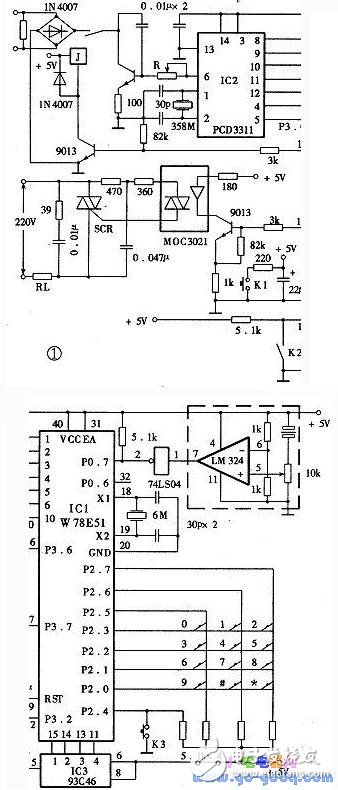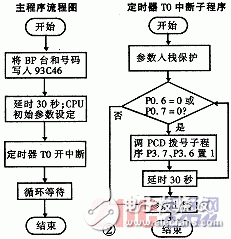The automatic dialer is an intelligent alarm monitoring device. It uses the single-chip microcomputer as the core device, and can use the wireless paging and program-controlled telephone to send the alarm to the designated BP at any time. After it is equipped with different sensors, it can not only report the leakage of toxic gases, theft at home, but also the occurrence of communication equipment and power failure. It can be widely used in warehouses, small shops, unattended communication stations. Station monitoring and home security, gas alarm.
working principleAutomatic dialers can be divided into two types, coded and simple, depending on the function. Coded automatic dialer can be manually set, change the BP machine number, easy to use and flexible; BP machine number of the simple automatic dialer has been written into the program memory of the CPU, has the characteristics of low cost, stable and reliable, the disadvantage is not artificial Change the BP machine number, need to write through the programmer, but the cost is lower than the codeable type. The following describes the working principle of these two dialers separately.
The codeable automatic dialer is shown in Fig. 1. The core part of the codeable automatic dialer IC1 is 89C51 from ATMEL Corporation or W78E51 from Taiwan Winbond. 89C51 and W78E51 are low voltage with 4K byte Flash PROM. CMOS 8-bit microprocessors are fully compatible with the standard MCS-51 series microcontrollers. It has a 4K byte flash PROM, 128 bytes of RAM, 32 I/O ports, 2 16-bit timers/counters, and 6 interrupt sources. Among the 32 I/O ports, P1 and P3 can be used as normal I/O ports. P0 and P2 are usually used as external data buses. When used as normal I/O ports, P0 pins must be connected with external resistors. IC2 (PCD3311) is a DTMF dual tone generator manufactured by Philips. It can interface directly with all standard single-chip microcomputers and receive binary or parallel serial data. The serial data format is I2C bus. D0 ~ D5 (8 ~, 4 feet) for the parallel data input port, MODE (3 feet) for the working mode selection port, in Figure 1, the port connected to a high level mode, used to enter parallel data. STR (5-pin) is the data strobe input and is controlled by P3.0 of the 89C51 or W78E51. TONE (6-pin) is a DTMF dual audio output. IC3 (93C46) is a serial EEPROM with a MICRO-WIRE bus structure. It is used to store the BP number entered from the keyboard. The data will not be lost after the power is turned off. The pins 1 to 4 of the IC3 are a chip select terminal (CS), a serial shift clock terminal (SK), a serial shift data input terminal (DI), and a serial shift data output terminal (DO). According to the level of the 6-pin level, there are 16 operation modes (6-pin connection to VCC) and 8-bit operation (6-pin grounding). The codeable auto dialer uses a 16-bit method.
P1.0 to P1.5 (1 to 6 pins) of IC1 are mainly used for the data interface of the PCD3311. P3.0 (10-pin) controls the data strobing of the PCD3311. P3.0 to P3.5 (2, 3, 6 to 9 feet) are used for the input of PCD3311 parallel data. P3.6 is used to control the relay. P3.7 controls optical coupling triac MOC3041 to connect 220V AC power. P3.1, P3.3, P3.4, and P3.5 are connected to 93C46. P2 is the keyboard's input interface. P0.7 is the input of alarm signal (the state of P0.7 is judged automatically, such as changing from high level to low level, namely dialing). The dotted line in Figure 1 is the alarm detection circuit, and M is the probe (such as harmful gas probes, temperature probes, etc.). A working principle is: When the probe detects changes in the external media, the surface resistance drops, the in-phase “+†input voltage rises, the comparator LM324 outputs a high level, and goes to a low level after passing the “non†gate. The P0.7 side of the CPU, P3.6, P3.7 from a low level to a high level, through the control of the relay and SCR, so as to connect the phone outside and 220V AC power. At the same time, the CPU calls the BP machine number that has been written to the 93C46 and sends a page through the PCD3311 to the outside line. The RL is a 220V power outlet and can be connected to various drive units or AC alarms depending on the situation. In practical applications, the front-end alarm detection circuit (such as infrared burglar alarm circuit) can be designed as needed. K1 in FIG. 1 is a system reset button, K2 is a normal/setting switch (keyboard input is valid in a closed state), and K3 is an end button. When entering the BP machine number, first set K2 to the “setting†bit. After the input is completed, press K3 and then K2 to “normal†position. The "*" on the keyboard is the delay mark key, which is different from the "*" key on the telephone. It should be noted that the number of the pager to be written should be an automatic station. For example, the writing format of the 127 automation station at the Telecommunications Bureau is 127 & TImes; & TImes; & TImes; & TImes; × × × (× × is the BP machine number) + delay flag . Since the paging format of other paging stations may differ from 127, the paging of other automatic stations can be imitated by using the "*" key flexibly. In order to prevent mis-dialing (because some probes will cause erroneous judgments when the surface resistance drops at initial power-on), when the software is programmed, a delay of 30 seconds is added to the initial state of the program. After connecting according to Fig. 1, it is possible to artificially make P0.7 low, and then adjust the adjustable resistance R carefully so that the BP function can accurately receive the dialing signal. It should be noted that if used as a gas leak, burglar alarms should be verified by relevant units to avoid accidents.

Figure 2 shows the software flow of the dialer. The main program completes the writing of the BP machine number and the setting of the CPU initial parameters; the interrupt subroutine completes the detection of the alarm signal, the dialing subroutine call, and the control of the relay and thyristor action. When the program detects an alarm signal, the interrupt subroutine will call the dial subprogram three times every 30 seconds until the alarm signal disappears. Of course, dialing subroutines can also be called repeatedly by modifying the software settings.

The ultra-thin precision cutting of the Anti-Peep Screen Protector means that you can enjoy a perfect touch screen experience without allowing anything on the screen to be peeped. Whether you place your phone horizontally or vertically, Privacy Screen Protector can protect your personal Information and sensitive information are protected from harm by strangers. People around you cannot see the contents of your phone, so your details are safe.
The use of soft TPU material can really cover the entire screen.
With self-healing function, it can automatically repair bubbles and scratches within 24 hours.
The 0.14mm Ultra-Thin Protective Film can maintain the sensitivity of the touch screen to accurately respond to your touch.
The oleophobic and waterproof coating prevents fingerprints, oil stains and other substances from adhering to it and keeps the screen clean.
If you want to know more about Privacy Screen Protector products, please click Product Details to view the parameters, models, pictures, prices and other information about Privacy Screen Protector products.
Whether you are a group or an individual, we will try our best to provide you with accurate and comprehensive information about Privacy Screen Protector!
Anti-Spy Hydrogel Screen Protector, Privacy Protection Film, Protection Film, Privacy Film, Privacy Screen Protective Film, Soft Film
Shenzhen Jianjiantong Technology Co., Ltd. , https://www.tpuscreenprotector.com